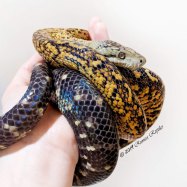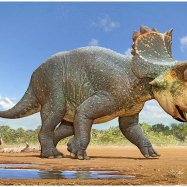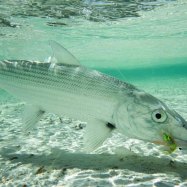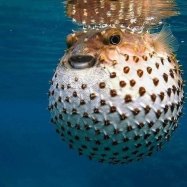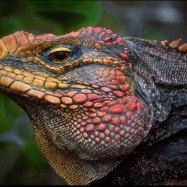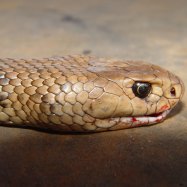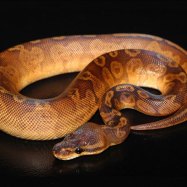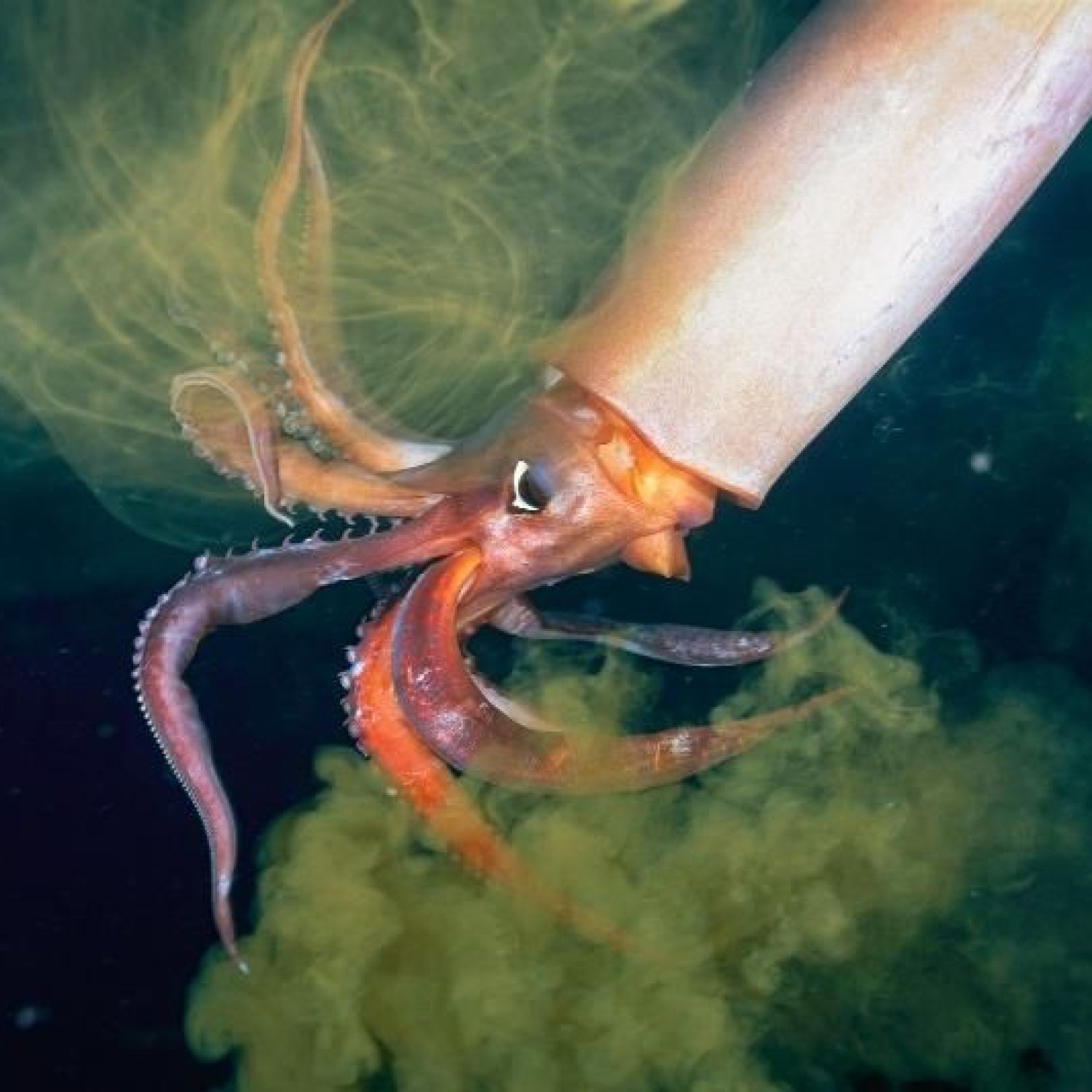
Humboldt Squid
Up to 6 feet (1.8 meters)
The Humboldt Squid, also known as the jumbo squid, can grow up to 6 feet in length and is found in the Pacific Ocean. Belonging to the Ommastrephidae family, they have a cylindrical and muscular body shape. These impressive creatures are a sight to behold in their natural habitat. #HumboldtSquid #PacificOcean
Animal Details Summary:
Common Name: Humboldt Squid
Kingdom: Animalia
Habitat: Open ocean, ranging from the surface to depths of 700 meters
The Mysterious Creature of the Pacific Ocean: Humboldt Squid
Deep beneath the turbulent waters of the Eastern Pacific, lurks a creature that has captured the imagination of scientists and thrill-seekers alike – the Humboldt Squid. With its powerful tentacles, eerie red coloration, and mysterious habits, this cephalopod has become a subject of fascination for many.Scientifically named Dosidicus gigas, the Humboldt Squid, also known as the jumbo squid or red devil squid, belongs to the kingdom Animalia and phylum Mollusca. It is a member of the class Cephalopoda, which includes other marine animals such as octopuses, cuttlefish, and nautiluses Humboldt Squid. These fascinating creatures have a unique body structure and behavior, making them stand out from other marine animals.
A Fascinating Habitat
Humboldt Squids are known to inhabit the open waters of the Pacific Ocean, ranging from the surface to depths of 700 meters. They primarily dwell in the Humboldt Current system, a cold, nutrient-rich current that runs along the coasts of Peru and Chile. This region is also known as the "Humboldt Sea," named after the famous German naturalist Alexander von Humboldt, who explored the area in the 19th century.
This current is essential to the squid's survival as it brings an abundance of food, including sardines, anchovies, and pelagic red crab. The Humboldt Current is also responsible for the reddish-brown to light pink coloration of these cephalopods, which allows them to blend in with their surroundings and avoid predators.
Carnivorous Feeders
Humboldt Squid are fierce predators, known for their voracious feeding behavior. They are carnivorous, meaning they feed mainly on other animals, including fish, crustaceans, and even other squid. These intelligent creatures use a variety of hunting techniques, including ambush, pursuit, and gang attacks, to capture their prey House Wren.
Their powerful tentacles are equipped with small, sharp hooks called suckers, which they use to grasp and immobilize their prey. Their beak, located at the center of their tentacles, is used to tear apart their food before it is swallowed whole. Humboldt Squids also have a unique "toothed" tongue, called a radula, which is used to scrape and break down food into smaller pieces.
A Predatory Pack Mentality
One of the most fascinating traits of the Humboldt Squid is its group hunting behavior. These mysterious creatures are known to hunt in large packs, sometimes numbering in the thousands. This coordinated hunting strategy allows them to take down larger and faster prey, such as fish and even other squid.
Scientists are still baffled as to how these squid can communicate and coordinate their movements effectively. Some studies suggest that they may use bioluminescence, a form of light production, to communicate with each other. Others believe that they use chemical signals released from their bodies to communicate and coordinate their movements.
Enigmatic Color-Changing Abilities
One of the most exciting features of the Humboldt Squid is its ability to change color. They have a complex system of specialized pigment cells called chromatophores, which can expand and contract to produce a range of colors, from reddish-brown to light pink.
Color-changing is essential for the squid's survival as they use it to camouflage themselves, attract mates, and communicate with each other. It is also believed that they may use color changes as a form of aggression or defense against predators.
The Giant of the Deep
The Humboldt Squid is a giant among its cephalopod relatives, growing up to 6 feet (1.8 meters) in length and weighing up to 100 pounds (45 kilograms). Their body shape is cylindrical and muscular, with eight long arms and two tentacles. Their strong and flexible muscles allow them to move quickly and efficiently through the water, making them formidable predators.
Despite their large size, these squid have a relatively short lifespan, only living for about one to two years. This brief lifespan is due to their intense feeding behavior and high metabolic rate, requiring them to consume large amounts of food regularly.
Threats and Conservation Efforts
The Humboldt Squid is not currently listed as endangered or threatened, but there is growing concern about the impact of human activities on their habitat. Overfishing, pollution, and climate change are all potential threats to their population.
Commercial fishing is the most significant threat to these squid, as they are often caught as bycatch in nets intended for other species. The use of sustainable fishing practices, such as selective fishing gear, can be crucial in protecting these creatures and their environment.
A Creature of Mystery
Despite their large size and bold coloration, the Humboldt Squid has remained largely mysterious to scientists. Due to their deep-sea habitat and elusive behavior, studying them is not an easy feat. However, technological advancements in deep-sea exploration, such as remote-controlled vehicles and underwater cameras, have allowed researchers to learn more about these enigmatic creatures.
One of the most fascinating discoveries about the Humboldt Squid is their incredible intelligence. They have large brains and an impressive capacity for learning, problem-solving, and memory recall. Scientists have even observed them exhibiting playful behavior, including chasing each other and playing with objects found on the seafloor.
A Captivating Creature
The Humboldt Squid is undoubtedly a captivating creature, with its unique body structure, intense hunting behavior, and mysterious habitat. From its ability to change color to its cooperative hunting tactics, there is still so much to learn about these elusive creatures.
As we continue to explore the depths of the Pacific Ocean and learn more about these fascinating cephalopods, it is crucial to prioritize conservation efforts to ensure their survival for future generations to come. The Humboldt Squid is a reminder of the incredible diversity and complexity of the marine world and the need to protect it for the benefit of all living creatures.

Humboldt Squid
Animal Details Humboldt Squid - Scientific Name: Dosidicus gigas
- Category: Animals H
- Scientific Name: Dosidicus gigas
- Common Name: Humboldt Squid
- Kingdom: Animalia
- Phylum: Mollusca
- Class: Cephalopoda
- Order: Teuthida
- Family: Ommastrephidae
- Habitat: Open ocean, ranging from the surface to depths of 700 meters
- Feeding Method: Carnivorous
- Geographical Distribution: Eastern Pacific Ocean, primarily in the Humboldt Current system
- Country of Origin: Peru
- Location: Pacific Ocean
- Animal Coloration: Reddish-brown to light pink
- Body Shape: Cylindrical and muscular
- Length: Up to 6 feet (1.8 meters)
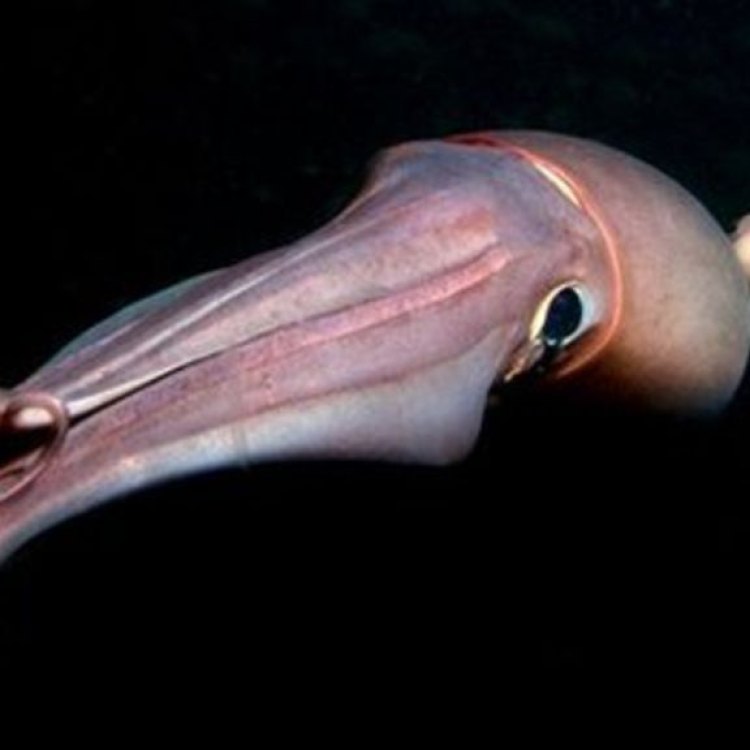
Humboldt Squid
- Adult Size: Up to 6 feet (1.8 meters)
- Average Lifespan: 1-2 years
- Reproduction: Sexual
- Reproductive Behavior: Mating occurs in large groups, with males competing for access to females
- Sound or Call: Known to produce clicking sounds, possibly for communication or navigation
- Migration Pattern: Vertical migration, moving between depths during different times of day
- Social Groups: Form large groups called shoals
- Behavior: Aggressive and highly active predators
- Threats: Fishing pressure and climate change
- Conservation Status: No formal conservation status
- Impact on Ecosystem: Top predator in its ecosystem, helping to maintain balance
- Human Use: Commercial fisheries target Humboldt Squid for their meat and ink
- Distinctive Features: Large size, strong arms with suckers lined with teeth
- Interesting Facts: Humboldt Squid have been known to display cooperative hunting behaviors and cannibalistic tendencies
- Predator: Orcas and sharks
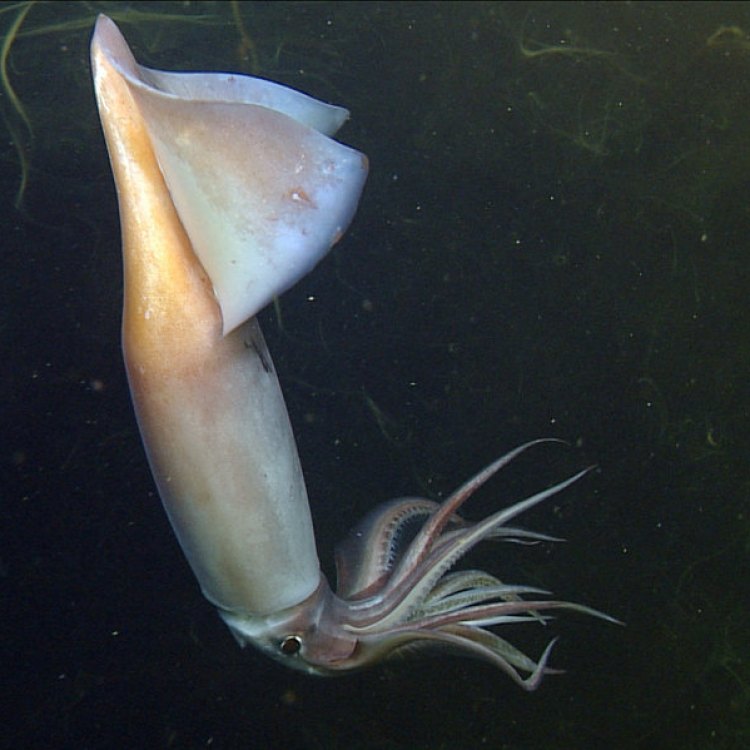
Dosidicus gigas
The Mighty Humboldt Squid: A Fierce and Fascinating Creature of the Deep Sea
In the vast depths of the ocean, there lives a creature that strikes fear into the hearts of even the bravest of divers – the Humboldt Squid. With its large size, aggressive nature, and unique features, this deep-sea dwelling creature has captured the fascination and curiosity of scientists and sea enthusiasts alike.The Humboldt Squid, also known as jumbo or jumbo flying squid, is a species of squid that belongs to the Ommastrephidae family. They are found in the eastern Pacific Ocean, specifically in the Humboldt Current off the coast of South America, from Chile to Mexico PeaceOfAnimals.Com. Named after the famous explorer and scientist Alexander von Humboldt, this squid has become a symbol of the mysterious and awe-inspiring creatures that lurk beneath the ocean's surface.
Adult Humboldt Squid can reach staggering sizes of up to 6 feet or 1.8 meters in length, making them one of the largest in the squid family. They have a torpedo-shaped body with 8 arms and 2 tentacles, each lined with numerous suction cups and sharp teeth. These teeth play a crucial role in capturing and gripping their prey, making them fierce and efficient predators.
Despite their large size, Humboldt Squid have a relatively short lifespan of only 1-2 years. This is due to their rapid growth rate and their high metabolism, which requires them to constantly feed and expend energy. This, combined with their aggressive and active nature, makes them a formidable force in the ocean's ecosystem.
When it comes to reproduction, Humboldt Squid follow the traditional sexual reproductive behavior Hornbill. However, what sets them apart is their unique mating rituals and behavior. Males will compete for access to females, and mating often occurs in large groups, known as spawning shoals. This behavior is believed to be a way for the squid to increase their chances of successful reproduction and genetic diversity.
One of the most intriguing aspects of the Humboldt Squid is their use of sound or calls. They have been known to produce clicking sounds, possibly for communication or navigation purposes. It is believed that these sounds help them locate and communicate with other squid, as well as navigate through the deep, dark waters of their habitat.
Humboldt Squid also have a distinctive migration pattern, where they move between depths during different times of the day. They are known for their vertical migration, with groups of squid traveling up to 300 meters deep during the day and coming closer to the surface at night. This pattern is thought to help them find food and avoid predators in different areas of the ocean.
These deep-sea creatures are highly social and often form large groups called shoals, sometimes consisting of over 1,000 individuals. Shoaling provides a means of protection against predators and helps them hunt more efficiently. However, within these groups, they can also display aggressive behavior towards each other, especially when competing for food or mates.
Speaking of food, Humboldt Squid are aggressive and highly active predators. With their large size, strong arms, and sharp teeth, they can take down prey that is even larger than themselves. They primarily feed on fish, crustaceans, and other squid, but have also been known to hunt in a coordinated and cooperative manner. This behavior, known as "yoyo hunting," sees the squid take turns attacking and feeding on prey, proving that these creatures are not only powerful but also intelligent.
Despite their fierce and impressive nature, Humboldt Squid face numerous threats in the ocean. One of the main threats is fishing pressure, as they are commercially targeted for their meat and ink. This has led to concerns about overfishing and its impact on the squid population. Additionally, like many other marine species, Humboldt Squid are also affected by climate change and ocean pollution, which can alter their habitat and food sources.
Currently, the Humboldt Squid does not have a formal conservation status, but their vulnerability to these threats makes their future uncertain. As one of the top predators in their ecosystem, their decline can have a domino effect on the entire food chain and the ocean's delicate balance.
Aside from their impact on the ecosystem, Humboldt Squid also have a unique relationship with humans. As mentioned, their meat and ink are highly sought after in commercial fisheries, with Mexico being the largest supplier of Humboldt Squid to the global market. In some cultures, they are also considered a delicacy and are a popular item on restaurant menus.
Despite their importance to the fishing industry, the Humboldt Squid is still somewhat of a mysterious and enigmatic creature. Scientists are continually studying and learning more about them, but there is still much to uncover about their behavior, physiology, and role in the ecosystem. With advancements in technology and our understanding of the ocean, we may one day uncover the secrets of these deep-sea giants.
In the meantime, there are a few interesting and lesser-known facts about Humboldt Squid that are worth mentioning. For one, they have been known to display cannibalistic tendencies, particularly towards injured or dying members of their own species. It is believed that this behavior serves as a way to maintain the overall health and strength of their shoals.
Humboldt Squid also have a few natural predators in the ocean, including orcas and sharks. However, their large size and aggressive nature make them challenging prey for these predators. In fact, they have been known to fight back against these predators and have even been observed trying to intimidate them with threatening displays of ink and arms.
In conclusion, the mighty Humboldt Squid is a truly remarkable creature of the deep sea. With its impressive size, unique features, and fascinating behavior, it has captured the imagination of humans for centuries. However, it is also a reminder of the delicate balance in our oceans and the need for its protection and conservation. As we continue to explore and learn about the deep sea, let us not forget the marvels that exist beneath the waves.
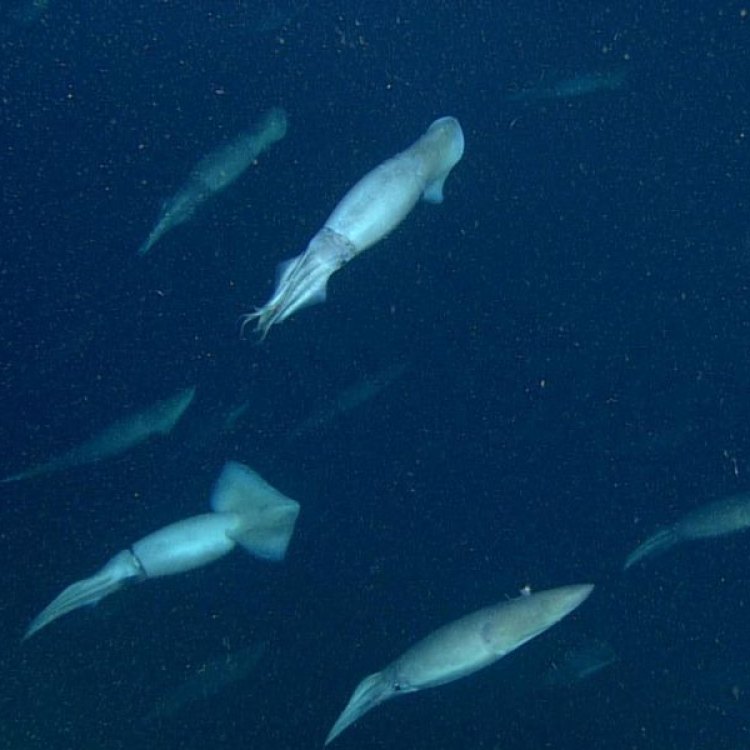
The Mysterious Creature of the Pacific Ocean: Humboldt Squid
Disclaimer: The content provided is for informational purposes only. We cannot guarantee the accuracy of the information on this page 100%. All information provided here may change without prior notice.




